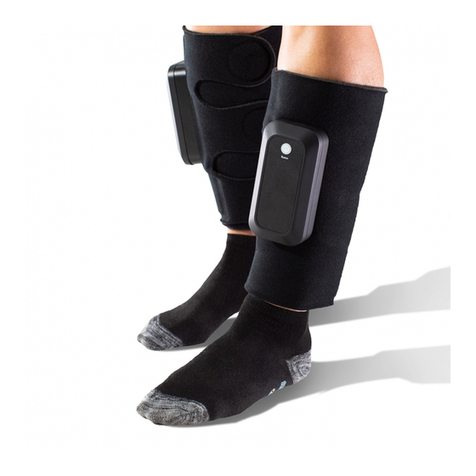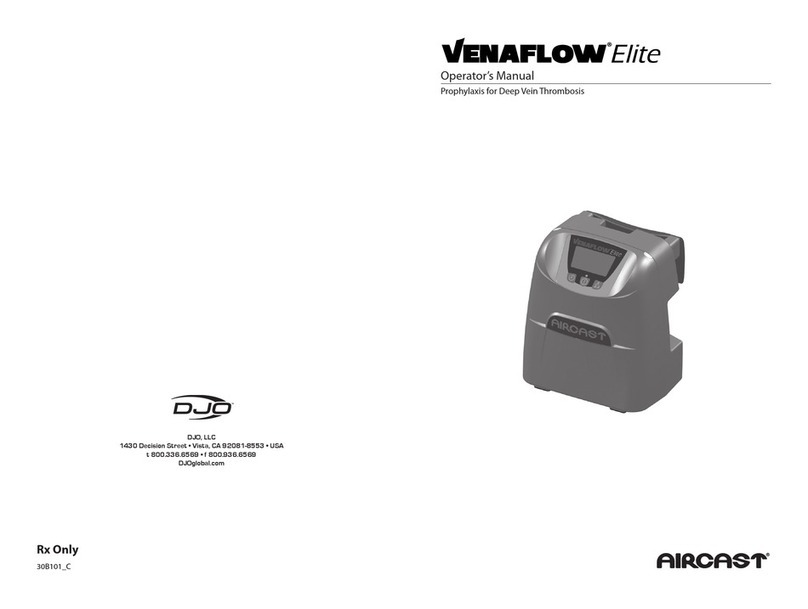2 3
Design Philosophy
Pneumatic compression is a clinically proven modality for minimizing the risks
associated with deep vein thrombosis.¹ The Aircast VenaFlow Elite System leverages
the same clinically proven technology as the existing VenaFlow oering, but is
presented in a low prole, light-weight design. VenaFlow Elite combines two proven
technologies, rapid ination and graduated sequential compression, to accelerate
venous velocity and enhance brinolysis. This unique combination makes VenaFlow
the only technology platform on the market that mimics ambulation.² Additionally,
VenaFlow Elite incorporates asymmetric compression for the superior emptying
of veins.³ The breathable and comfortable VenaFlow Elite calf, foot and thigh cus
enhance the patient experience, assist in increasing compliance and are compatible
with one universal pump.
Function
Standard Operation (rapid ination): The VenaFlow Elite system defaults to a
rapid ination mode. Once powered on, the system begins the compression cycle
and inates the cus one leg at a time, alternating between the two legs every 30
seconds. First the distal aircell inates rapidly within less than 0.5 seconds, then the
proximal aircell follows. The distal pressure peaks at approximately 73 mmhg ±15%
and the proximal pressure peaks at approximately 63 mmhg ±15%. These pressures
then settle at 45mmhg ±10% and after 6 seconds, the cu deates. In 54 seconds, the
ination cycle begins again. An icon will appear on the graphical display signalling
when the ination cycle is in progress. (See‘Pump Features’section) Pressure and the
inate/deate cycle are automatic and an alarm will be activated if the system is not
functioning properly. (See‘System Alarms’ section).
S Mode Operation (slow ination): The user has an option to select the S mode
button to switch to a slower ination mode. After selection, both cus begin to inate
simultaneously once every 60 seconds. The ination cycle is approximately 10 seconds
long. The aircells inate to a peak pressure of 45mmhg ±10%. In 50 seconds, the
ination cycle begins again. In S mode, pressures are automatic and alarms function
normally.
Intended Use/Indications
The VenaFlow Elite System is an intermittent pneumatic compression device that
is intended as a prophylaxis for deep vein thrombosis (DVT) in a clinical setting or
in the home. The VenaFlow Elite System is designed to be used only with VenaFlow
Elite cus.
Contraindications
The VenaFlow Elite System should not be used by persons with known or
suspected deep vein thrombosis, severe congestive heart failure, pulmonary
edema, thrombophlebitis, severe arteriosclerosis, or active infection. Do not
use on extremities which are not sensitive to pain, where cu will interfere
with gangrene, on patients with vein ligation or recent skin grafts, or extreme
deformity of the leg. Do not use the VenaFlow Elite System where increased
venous or lymphatic return is undesirable.
Warning and Precautions
• TheVenaFlowElitecusaredesignedforsinglepatientuseonly.
• Riskofexplosionifusedinthepresenceofammableanaesthetics.
• Theequipmentorsystemshouldnotbeusedadjacenttoorstackedwithother
equipmentand,ifadjacentorstackeduseisnecessary,theequipmentorsystem
should be observed to verify normal operation in the conguration in which it will
be used.
• MedicalElectricalEquipmentneedsspecialprecautionsregardingEMC.Portable
and Mobile RF Communications Equipment can be aected by other Medical
Electrical Devices.
• Cususedincombinationwithwarmingdevicesmaycauseskinirritation.
Regularly check for patient comfort, compliance and skin irritation.
• Specialattentionshouldbegiventothosepatientswithneuropathiesortissue
viability problems (i.e. diabetes, arterial or venous insuciencies).
• Topreventextremitycompartmentsyndrome,specialattentionshouldbegiven
to patients who are positioned in the supine lithotomy position for extended
lengths of time. This includes patients with or without compression cus.
• Ifyouexperiencepain,swelling,sensationchangesoranyunusualreactionswhile
using this device, consult your medical professional immediately.
• Footcusareonlyforuseinstandardrapidinationmode.
• Ingressofwaterorliquidscouldresultinunpredictablefailures.
• Inspectequipmentforobviousdamagepriortouse.
• Donotwalkwithtubingconnectedtocus.
• Thedeviceshouldneverbeopenedbyanyoneotherthanatrainedtechnician.
• Useofdeviceoutsideofallrecommendedspecicationscouldresultinunpredictable
failures.
Latex Information
All components of the VenaFlow Elite System are latex-free. All VenaFlow Elite
cus are latex free and may be placed directly against the skin or over a light
compression dressing.
1. Labropoulos N, OH D.S, Golts, E, et al: Improved Venous Return By Elliptical, Sequential and Seamless
Air-cell Compression. Loyola University Medical Center, January 2003.
2. Whitelaw G, Oladipo O, Shah BP, et al: Evaluation of Pneumatic Compression Devices. Boston Orthopedics,
March 2001.
3. Kamm R: Unsteady Venous Blood Flow Resulting From Different Modes of External Compression Cambridge,
MIT, 1996































